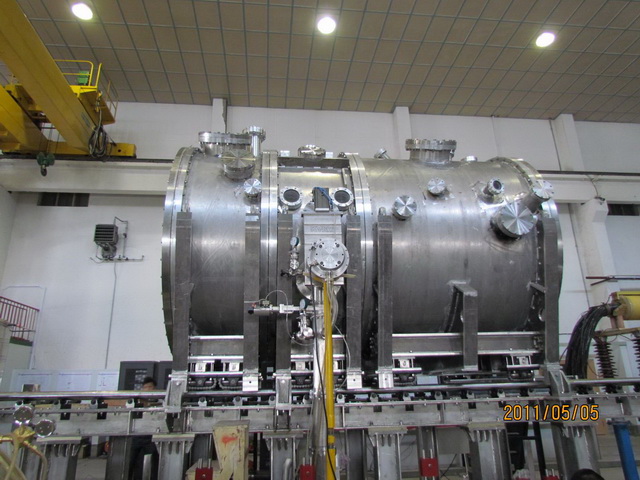
count: [2011-05-25] [Close]
The construction of the vacuum chamber on test bed of EAST neutral beam injector (NBI) has been completed in ASIPP. The test shows that the vacuum pressure can reach 6.3×10-4 Pa under the pumping of turbo molecular pump set.
The vacuum chamber is one of the most important parts of the NBI system, which is the main channel for the beam transmission, and provides a vacuum environment and supporting platform for various internal components. In front of the vacuum chamber, there are two high-current ion sources, connected by two high-vacuum pneumatic flapper valves respectively. Between the vacuum chamber and the tokamak, there is another high-vacuum pneumatic flapper valve and the drift duct. Thus, the channel for the beam transmission is formed, from the ion source to the tokamak.
The vacuum chamber is cylindrical and divided into three parts with inner elements, , at the dimension of Ф2400mm×1900, Ф2400mm×889 andФ2400mm×864. To obtain an excellent vacuum performance, the rational layout of each inner element of the beamline is very important. The rear cryopanel, neutralizer and ion dump are installed in the first beam transport vacuum chamber. The reflecting magnet is installed in the second beam transport vacuum chamber. The front cryopanel and calorimeter are installed in the third beam transport vacuum chamber. In order to meet the physical target, the main vacuum chamber is made of aluminum material. No leakage was found in the leak detection, under the range of 1 × 10-10Pa.m3.s-1, for the vacuum chamber and the sealing surfaces of both cover ends, which is the requirement of design. At the same time, taking into account the NBI large vacuum chamber, hefty weight, high precision for connectivity, the vacuum chamber support system is made of the basic support and the adjustive structure. The adjustive structure is in the form of a dual rail at the length of about 7 m, 1.7 m width.
“In the next phase, our main task is the installation and commissioning of internal components inside the vacuum chamber”, said Prof. Chundong HU, head of NBI team. “All these work will lay a good foundation for the high current ion source beam extracted experiment by the end of this year.” (Liu Ling Reports)